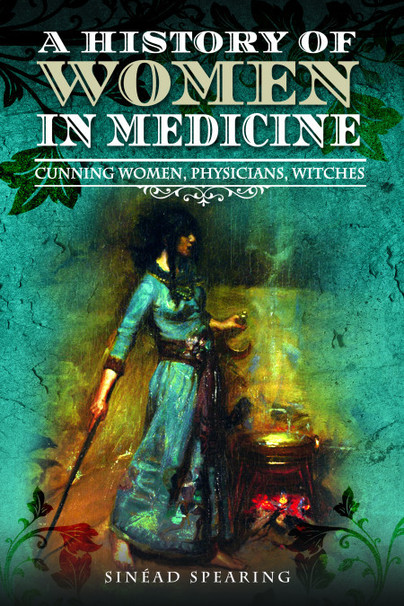Witch Week – Cunning-Women and Witches
How ancient physicians were demonised as witches and wiped from the historic record.
Guest post from author Sinéad Spearing.
When the first cunning-woman was dug from her sixth century Anglo-Saxon grave, archaeologist Tania Dickinson heralded her as ‘a woman with special powers’. Earth and bone revealed unusual grave goods such as scalpels, antler cones, threads and organic matter. Also, mysterious metal tubes and amuletic bucket pendants all hinted at a woman with medical knowledge living during a time when medicine was magically inspired within a supernatural cosmology.
If bones alone preserved these women then we would know little more. Yet from forgotten Old English herbals, scorned as barbarian hocus-pocus with their spells for elves, nightwalkers and the moon-mad, come some intriguing remedies: Wormwood is prescribed for coughs and nightshade for somnambulistic disturbances. Tiny metal tubes blow ointment onto wounds too sore for human hands to touch and antler cones drip exact quantities of ointment into eyes and ears.
If a patient has worms in the eyes for example, then we can imagine the tiny scalpel being used:
If worms be in the eyes, score inside the eyelids, put celandine juice into the cuts, the worms will be dead and the eyes healthy.
Gid wyrmas sien on eagum scearpa þa br æwas innan, do on þa scearpan celeþonian seaw, þa wyrmas bioþ deade ond þa Eagan hale.
Amuletic pendants ward off attacks from elves, hags and nightwalkers that haunt twilight, and red threads — a tradition from Celtic magic — are used for curing headaches:
‘Dig waybread without iron and before the sun rises, bind the roots around the head with a red thread, it will soon be better for him.’
‘Adelf wegbrædan butan isene ær sunnan upgange, bind þa moran ymb þæt heafod mid wræte reade þræde, sona him bið sel.’
Preserved in the herbals of Bald’s Leechbook and the Lacnunga manuscript are remedies and spells used by ancient cunning-women to heal the sick and protect their communities from harm. Students from Nottingham University have even discovered, by chance, that a remedy for a cyst cures the superbug MRSA where modern antibiotics fail – so much for barbarian hocus-pocus.
Today the term cunning-woman has been lost from regular parlance and is confused with the loaded term ‘witch’, mingling ancient healing with notions of evil. Their loss to medical history and re-branding as hook-nosed devil worshippers is explained by Curator Sue Banning from the British Museum as being a consequence of their special and powerful nature, she says, ‘these women were very well respected, but they were quite feared as well. They may have been on the margins of society.’
Feminist writer Mary Daly expands this idea stating that the subordination of women in general should be affixed firmly to St Augustine’s door. His attitude towards women fueled an infestation of dogmatic misogyny that planted a suspicion and revulsion of women in the hearts of many clergy, resulting, hundreds of years later, in this:
What else is woman but a foe to friendship, an inescapable punishment, a necessary evil, a natural temptation, a desirable calamity, a domestic danger, a delectable detriment, an evil of nature painted with fair colours.
Revd Kramer, The Malleus Malificarum, 1487.
The Malleus rarely fails to stun its reader. By the time of its publication, the word witch is used commonly to describe female healers as ‘workers of harmful magic’. Yet ‘witch’ is a word with humble origins.
‘Witch’ or ‘wicce’ in Old English, began life as a simple tribal name – Hwicce. During the Dark Ages the Hwicce tribe inhabited the area of England famous today for Stonehenge, Avebury and the Cotswolds and it is here where our cunning-woman and others like her have been found.
The tribe were loyal to Woden from whom King Penda, ruler of the tribe during the seventh century, had descended. Perniciously pagan therefore, they irked King Alfred (849-899) and threatened his dream called England – a land united under one king and one religion.
Unwilling to yield their heathen traditions, however, Alfred devised a cunning plan: Re-brand the troublesome Hwicce as evil until their very name embodies the worst blasphemy against Christ – satanic sorcery. Cunning-women, so respected and powerful, were to be specifically targeted.
The plan succeeded: In 780 we find the Hwicce mentioned in a Royal Charter as a simple tribe. Yet by 979 their name has become Anglicised as wicce and the meaning changed to refer to sorcery alone. It took just two hundred years for an innocent tribal name to turn into a symbol of evil so potent that thousands would later die in a craze of witchery.
Yet by teasing out the true identities of cunning-women from the historic record, a very different understanding of them is consequently revealed, from before the word ‘witch’ conjured images of green skin, hooked noses and unholy unions with the devil. From centuries of attempts to eradicate cunning-women, such as the Augustinian reworking of woman’s role in sin, the misogynistic writing of Bishop Prüm, the assimilation of paganism by Pope Gregory and the infamous Malleus Maleficarum (and all this before the advent of the witch trials), it becomes clear that condemning them, changing their tribal name to witch, torturing them, burning them and re-branding their pagan beliefs as evil, has only served to confuse, confound and portray women as lesser creatures than men – a view which, arguably, persists today.
Sinéad Spearing is an author and cultural historian specialising in the history of folk-healing and spirituality. Her books include Old English Medical remedies and A History of Women in Medicine.



